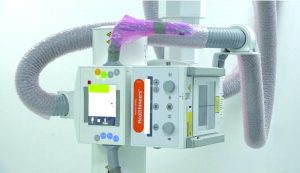Home News All analogue X-ray machines being replaced with digital versions – Health Minister
…as GPHC’S capacity enhanced with new machines
The Health Minister, Dr Frank Anthony, has announced that the Government has decided to retire analogue X-ray machines which are to be replaced with new advanced and digitalised X-ray machines. 
“In our systems right now we still have a lot of analogue machines…we still doing that in some of the sites and that’s creating a lot of problems because of the films and it’s so time consuming, so that has been a challenge…we have taken another decision and that is that, we are going to retire those machines.”
“And we are going to go into the digital era where all the X-ray machines that we’re buying would be digital and for the same reason…in terms of getting the images quickly, accessing it and being able to make to timely diagnosis.”
“We have procured or in the process of procuring another 3, such machines so they will be coming in and going to some of the other regional hospitals.”
The Minister made this announcement at the handing over of two such machines as well as another portable X-ray machines to the Georgetown Public Hospital Corporation (GPHC).
“We spent some time looking at how we can standardise X-ray machines in the country and we had a technical committee that sat for several weeks debating, contemplating on the different types of machines in the world and which would be the best and so forth.”
“They have advised that we should now use three or four brands and they have recommended this, and the reason why is that over the years we have seen X-ray machines being bought but within a year or two they are not working,” he said.
The two Siemens X-ray machine and one portable Elara max X-ray machine were procured in June last year at the cost of $113.8M and was officially handed over to the GPHC Saturday morning.
The Chief Executive Officer (CEO) of the GPHC, Robbie Rambarran, explained that these machines are highly digitalised and suited for the emergency use.
“We started we reviewed many brands of X-ray machines… we looked at after sale service and support, we looked at spare parts availabilities, we looked at if they had the capabilities to respond in an emergency and also train our staff…because many years we had this type of machines (Siemens) and its one of the gold standards in healthcare and, the machine is suited for the volume. We do lots of X-rays here almost 300 different types of X-rays per day.”
He added that these types of equipment are highly digital, “It’s not like long ago, most patient will not go home or will not get an actual X-ray, when we finish shooting an exposure it is automatically via the internet or via Wi-Fi connection or some cases it’s loaded to a pact system which is a digital system.”
He said these scans can now be transferred to anywhere in hospital even to other external facilities.
“So, if a doctor from Enmore sends here for a specific X-ray, we don’t have to give the patient a film, it automatically loads and they click on their computer there and they can access it,” he added.
Rambarran said too that there was previously a shortage of some X-ray services at the hospital which has now been eliminated by the acquisition of the new machines.
“In February of last year when I re-joined in this institution it was immediately brought to my attention that there is an absence of X-ray services here…we had a few X-ray machines here, there was G brand one it was acquired since 2002, then a Siemens was acquired since 2015 and then there was a Fluoro that was acquired 2014 and installed 2015.”
“But these went down and the reason why it went down is because in the latter part of 2015 there was no preventative maintenance so going into 2016, we had significant problems.
Modern, digitalised equipment
Meanwhile, Minister Anthony explained that the new regional hospitals that have been announced to be built from this year’s budget will also comprise of modern and digitalised equipment not only for X-rays but other services such as CT scans.
“You would have heard in the budget that we spoke about new regional hospitals and there are 6 new ones that are going to build on new sites and there are two new hospitals that will be built on existing sites meaning at West Demerara and Bartica.”
“These buildings when they are completed, it is not just the building, but they will have a new section for imaging, a new section for laboratories, in patient, accident and emergency outpatient and so forth.”
“And in the imaging section, all of the equipment that are going to be there is going to be digital, some of the modern piece of equipment and not only to X-rays but we’ll be adding CT scans and some other types of imaging equipment.”
The Minister added that 200 million dollars in works will be done at the Festival City Polyclinic which falls under the GPHC’s control, to ensure that they have such modern and necessary equipment and to reduce the patient load going to the GPHC.
In this year’s GPHC budget, an additional 300 million dollars will be spent on equipment for the said hospital.
